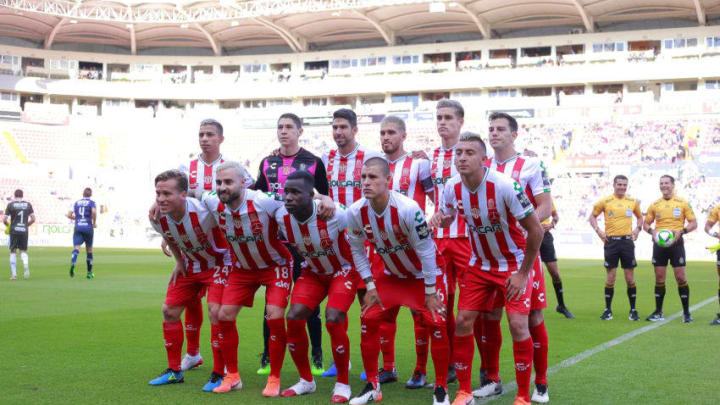Necaxa fans are fond of declaring “Somos pocos, pero contentos” (especially those of us who frequented the often-vacant Estadio Azteca to watch our beloved Rayos). In the 1990s, we exulted in that phrase: “We are but few, yes, but we’re quite content.” This is Part I of a three-part series on the history of Club Necaxa.
Much to the surprise of pundits, Necaxa has been nosing around the top of the Liga MX table for the past several months, hearkening back to the famous Rayos team known as El Campeonísimo.
True fans of Mexican soccer would be quick to ask “Which team are you referring to?” Such a question would not be derisory, instead it would recognize the rich history of the Necaxa soccer club founded in 1923.
The Rayos are one of the oldest football clubs in Mexico and they were the first dominant team in the nation. Their first Glory Days came in the amateur era and “Los Once Hermanos” ruled the 1930s, winning four league titles and two Copa Mexico trophies. They were the first club to win a double (the league and the Cup in 1932-33).

However, the reference in the opening paragraph was a nod to the most recent glory days – the 1990s – during which the Rayos won three Liga MX titles.
Since then, Necaxa fans have suffered disappointment – two demotions to second division – as well as feelings of abandonment (when the Rayos moved from Mexico City to Aguascalientes). Unfortunately, such emotions have long been part and parcel of being a Necaxa fan. The team has disappeared and returned on more than one occasion.
But before the heartbreak of emotional abandonment came great success … and success returned for a glorious decade in the 1990s. Nowadays, success for Necaxa is measured by a single-season playoff run. At this point, we Rayos fans will take what we can get.
The original ‘Team of the Decade’
First came the Once Hermanos and their five trophies in the 1930s. That Rayos team was led by two-time league scoring leader Julio Lores and his strike partner Hilario “El Moco” López, a three-time scoring champ. The Electricistas were the first Mexican club to win an international tournament. Necaxa attended the 1935 Central America & Caribbean Games held in El Salvador as Mexico’s representative. Basically, the Rayos posed as El Tri and came home with the Gold Medal after winning all five games by a combined score of 29-5.
More from Viva Liga MX
- Guillermo Ochoa is out 4-6 weeks
- The Clásico Regiomontano is Heating Up
- Pumas: In Search of Regaining a Top Spot
- Why the United States Is Set to Overtake Mexico on the World Stage
- Erick Gutierrez is out once again
The championship window for the Rayos was extended by the arrival of Horacio Casarín, one of the all-time great Necaxa legends. “Chamaco” debuted as an 18-year old in 1936, contributing to the back-to-back league titles the Rayos won in 1936-37 and 1937-38. Unfortunately, the Rayos were denied a three-peat after Casarín suffered a season-ending knee injury in 1939. That incident culminated in the destruction of the Parque Asturias by rioting fans.
A few years later, a professional soccer league was formed, causing a dilemma for Necaxa. Ownership declared that team values opposed the commercialization of soccer and they pulled the plug on the Rayos. The team simply folded.
When Necaxa fans were suddenly left without a team in 1943, and Casarín signed with Atlante, most Rayos fans switched allegiance and became Potros fans. Many never forgave Necaxa for “disappearing,” swearing off their support for the club, even after the team returned for the 1950-51 season.

Casarín starred at Atlante, then spent a year with Barcelona (1948) before returning to Necaxa for the 1950-51 season. He led the league in scoring that year, netting 17 times in 21 games. That made “Chamaco” Necaxa’s first-ever professional scoring champion. There have only been six since, the last being Agustín Delgado who shared the league lead with 14 goals during the Verano 2000 campaign.
Casarín is often cited as Mexico’s first national soccer hero. The game was dominated by British and Spanish players in the early years of amateur football in Mexico before “El Chamaco” came along. His goal-scoring exploits made him an idol and his league record for most goals scored (238) stood for more than 25 years until Pumas star Cabinho smashed it in 1982. It was not until 1997 that Carlos Hermosillo finally surpassed Casarín to become the highest-scoring Mexican of all time.
“… the weird turn pro”
The Rayos made their professional debut on Sept. 24, 1950, settling for a scoreless draw against the Chivas. Necaxa struggled to compete in the upper echelons of the league, never coming close to a league title. However, the Rayos won the Copa México twice (back when the Cup enjoyed more prestige than it does now. The Rayos hoisted the Cup in 1960 and 1966.
Necaxa also made front-page headlines around the world in February 1961 when they defeated Pele’s Santos team in an invitational tournament known as a Pentagonal. Necaxa defeated the world’s best team 4-3 at UNAM’s stadium, then the largest in Mexico (Estadio Azteca was built five years later). El Universal relived the game in their delightful history column, Mochilazo en el Tiempo.
Despite these occasional joyous highlights, the Hidrorayos were a middling team. As the 1970-71 season wound down, Necaxa ownership decided they could not maintain the team. The club was sold to a group of Spanish investors and they changed the name of the team to Atlético Español. Necaxa had disappeared again!
Rayos fans were orphans once again and this time the feelings of abandonment lasted 11 years.
